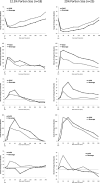Food form and portion size affect postprandial appetite sensations and hormonal responses in healthy, nonobese, older adults
- PMID: 19629055
- PMCID: PMC4297632
- DOI: 10.1038/oby.2009.217
Food form and portion size affect postprandial appetite sensations and hormonal responses in healthy, nonobese, older adults
Abstract
Data are limited concerning the dietary factors that influence appetite control in older adults. This study examined the effects of food form and portion size on appetite in 43 older adults (age: 72 +/- 1 years; BMI: 25.6 +/- 0.3 kg/m(2)). Subjects were assigned to groups based on portion size of the test meal (12.5% (n = 18) vs. 25% (n = 25) of estimated energy need). Subjects randomly consumed, on two separate days, the respective solid or beverage test meal. Appetite sensations and hormonal responses were measured over 4 h. Main effects of food form (P < 0.05) and/or portion size (P < 0.05) were observed for each appetite sensation. Postprandial hunger and desire to eat were greater following beverage vs. solid meal (between 12.5% vs. 25%), whereas fullness was lower after beverage vs. solid meal (P < 0.05). Main effects of food form and/or portion size were observed for glucose, insulin, and ghrelin. Postprandial glucose and insulin concentrations were lower after beverage vs. solid meal (between 12.5% vs. 25%; all comparisons, P < 0.05) whereas beverage meal led to greater 4-h ghrelin vs. solid meal (P = 0.09). No main effects were observed for glucagon-like peptide-1 (GLP-1) or cholecystokinin (CCK). When adjusting for age, food form remained significant for postprandial hunger and fullness; portion size remained significant for postprandial glucose. Greater hunger and reduced satiety with accompanying glucose, insulin, and ghrelin following the beverage vs. solid meals, and to some extent, in smaller vs. larger portions suggest that appetite control is influenced by food form and portion size in older adults. These findings may enhance the development of appropriate dietary strategies that help to regulate energy balance.
Figures



References
-
- Facts for Features. Office CBsPI; 2006. www.census.gov/Press-Release.
-
- Roberts SB, Rosenberg I. Nutrition and aging: changes in the regulation of energy metabolism with aging. Physiol Rev. 2006;86:651–67. - PubMed
-
- Mattes RD, Rothacker D. Beverage viscosity is inversely related to postprandial hunger in humans. Physiol Behav. 2001;74:551–7. - PubMed
-
- Mourao DM, Bressan J, Campbell WW, Mattes RD. Effects of food form on appetite and energy intake in lean and obese young adults. Int J Obes. 2007:1–8. - PubMed
-
- DiMeglio DP, Mattes RD. Liquid versus solid carbohydrate: effects on food intake and body weight. Int J Obes Relat Metab Disord. 2000;24:794–800. - PubMed
Publication types
MeSH terms
Substances
Grants and funding
LinkOut - more resources
Full Text Sources
Medical

